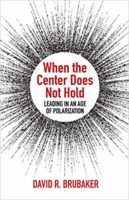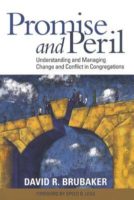by David Brubaker
I love being part of a “church family.” It feels warm and comforting, and I look forward to seeing my spiritual “sisters and brothers” (along with a number of “cousins”) every Sunday morning. But adopting a “community” metaphor will be healthier for most congregations than persisting with a “family” metaphor. When we think of our congregations only as “families” our greatest desire may be to nurture and protect them. When we think of them primarily as “communities” our question may become, “how do we release them?”
In last week’s post Dan Hotchkiss observed that “a church or synagogue always is two congregations at the same time”—simultaneously an organization (institution) and a family. Another way to describe this paradox is that every congregation possesses both a formal structure and an informal culture—and that the two coexist, as Dan says, in a “tension to be lived with, not resolved by victory or defeat.” There is no escaping the institutional realities of the modern congregation—budgets need to be prepared, staff hired, and bills paid. But the “family” metaphor that served us well for centuries is increasingly being supplanted by an alternative vision of the congregation as a community.
Why is this happening? The “family” metaphor, while communicating close “brother and sister” ties, suffers from three significant liabilities in many parts of North American culture:
- Many have experienced pain and brokenness in their families of origin, and the initial reaction to an invitation to “come join our congregational family” may be fear and pain rather than joy and gladness.
- The overarching purpose of a family, as Carl Strikwerda points out in a recent Messenger article, is to support and encourage its members. Families, he observes, generally “do not have an outward focus or purpose.”
- Families often have clear if not rigid boundaries that delineate who is “in” and who is “out.” While a given family may demonstrate a profound gift of hospitality, it’s one thing to be hosted well and something else to genuinely belong.
By contrast, the “congregation as community” metaphor offers three significant perceptual advantages to those who are currently part of a congregational community and for those who are considering joining it:
- While some neighborhoods and communities are as broken as any dysfunctional family, most of us have been privileged to live in (or at least spend time in) a community that was reasonably functional. Unlike the primal reaction that many have to an invitation to “join our family,” it’s rarer to encounter someone with a similar depth of trauma regarding the prospect of joining a community.
- While families exist to support (if not shelter) their members, communities are places where we experience not only support but also an expectation of service in the broader community. Through a complex of services (such as schools, businesses, government, and non-profits) a healthy community strives to not only meet its own needs but often to also serve a surrounding area.
- Most critically, while one has to be either “born in” or “adopted in” to a family, you simply choose to “move in” to a community. Boundaries in a community can (and should) be clear, but they are less likely to be rigid than those in a family.
From a theological perspective, both the Hebrew and the Christian scriptures resonate with rich examples of the people of God as a community. In the Hebrew Scriptures, God calls and works through a covenant community that is to also be a “light to the Gentiles.” In the Christian Scriptures, Jesus calls and trains a community of disciples that continue to invite others to join them even after the founder’s death. The Greek word “koinonia” captures this sense of fellowship (or community) that was expressed by the life together of the early followers of Jesus.
Finally, there are multiple empirical examples of congregations that have determined to express their life together in terms of a “community” rather than a “family.” The vision statement of my own congregation, Park View Mennonite Church in Harrisonburg, Virginia, calls us to become a “community of communities engaged in God’s mission.” In practical terms, this vision means we increasingly view our congregation as composed of multiple small groups that themselves provide both support to members and mechanisms for service. Many larger congregations have also adopted cell group models that presume a “community of communities” metaphor.
Although I believe that adopting a “community” metaphor is healthier for most congregations than persisting with a “family” metaphor, many smaller congregations will continue to perceive themselves primarily as families. Family-size congregations, with up to 75 active members, particularly, often feature a church matriarch and/or patriarch and thus function as a family. The likelihood of changing such a congregational culture to resemble a community more than a family is indeed smaller than the odds of doing so in a larger congregation.
Congregational metaphors are powerful for two reasons. First, they symbolically express what we most value about our congregations. Second, they simultaneously shape our understanding of what it means to belong to the congregation. Thus, we should take great care in how we conceptualize our congregations. Whether as a body, a family, or a community—the metaphors that we employ to describe our congregations will ultimately contribute to determining who they, and we, become.
The challenges of our life together in community may be no less significant than the challenges we now face as a self-perceived family. There will still be bills to pay and budgets to prepare, and we will still need to find that elusive balance between our inner-focused “support” and our outward-focused “service.” As Strikwerda concludes, “the deepest lesson God teaches us through living in community is how much a life lived for others leads to fuller life for ourselves.”
David Brubaker has consulted with organizations and congregations in the U.S. and a dozen other countries on organizational development and conflict transformation. He is the author of Promise and Peril, on managing change and conflict in congregations, and When the Center Does Not Hold, on leading in an age of polarization. David recently retired from his role as Dean of the School of Social Sciences and Professions at Eastern Mennonite University, and is now a Professor Emeritus of Organizational Studies.


